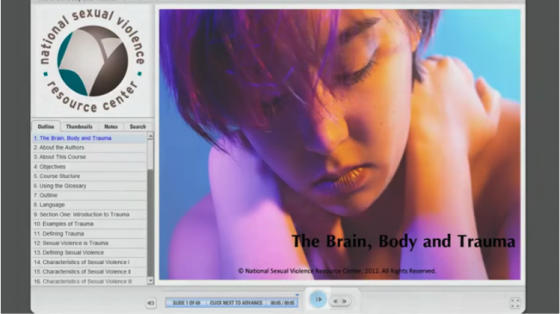Child development refers to the biological and psychological changes that occur in human beings between birth and adolescence, progressing from dependency to increasing autonomy. Although there are several models describing this progression, it is important to remember that children are individuals with varying levels of ability, and this must be taken into account in order to gain a fuller understanding of the experience of any one child.
The negative impacts (both short- and long-term) of trauma have been well researched and well documented. Domains of impairment may include:
- Attachment
- Biology
- Affect Regulation
- Dissociation
- Behavioral Control
- Cognition
- Self Concept
Research on the impact of trauma on the brain has shed light on the ways in which children with repeated exposure to violence may face deficits in their capacity to regulate emotion and behavior, and access memory.
This video from Children Without a Voice explores the impact of repeated exposure
to violence on children’s brain development.

This online course by Kelly Wilt & Janine D’Anniballe for the NSVRC (2012) provides an overview of the neurobiological and psychological implications of sexually violent trauma and the information and skills necessary for victim service providers to provide trauma-informed services.
However, new research reveals the brain’s amazing ability to heal and grow. “The way we live and the quality of relationships we have can either help or hinder the potential of our brains to grow and heal. Depression, high levels of stress, and substance abuse can reduce the brain’s ability to recover. However, physical activity, developing new skills, healthy relationships, and being socially active help our brains to form new connections. It’s never too late to get help and start healing” (Chamberlain, 2008).
Beyond the human potential for healing and thriving – both biologically and emotionally, some suggest a counterbalance to the incomplete deficit model for understanding the human experience after trauma. In his keynote at the 3rd International Pathways to Resilience conference in June, Bruce Ellis of the University of Arizona explains the concept of post-traumatic growth. He notes that we need to “see through the darkness to leverage what it gives us” (2015), explaining how ACEs (adverse childhood experiences) can develop specialized skills for adaptation. If we are able to recognize and celebrate the positive changes that can occur after trauma, we can best promote the factors that bolster resilience capacity.
“The healing process isn’t about becoming who you might have been had you not experienced trauma. It’s about integrating the wisdom you have gained from this experience into your life.” Psychology Today, 2015









